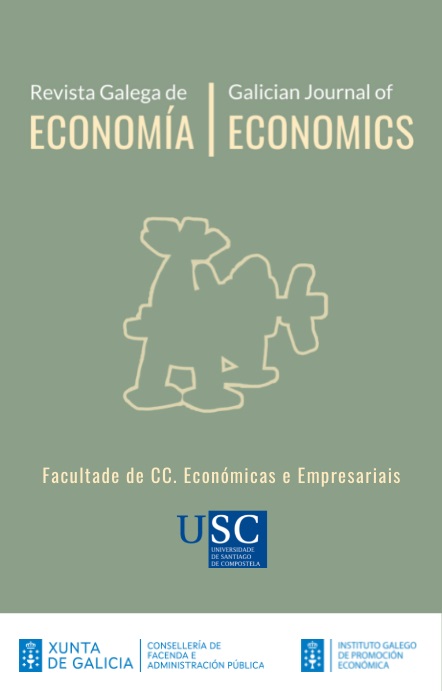Los desequilibrios por cuenta corriente y la crisis en la eurozona
Contenido principal del artículo
Resumen
Palabras clave:
Detalles del artículo
Referencias
BAHMANI-OSKOOEE, M.; NIROOMAND, F. (1998): “Long-Run Price Elasticities and the Marshall-Lerner Condition Revisited”, Economic Letters, 61 (1) (October), pp. 101-109. Elsevier Science.
BANCO MUNDIAL: <http://data.worldbank.org/indicador/FS.AST.DOMS.GD.ZS>.
BAJO, O.; MONTERO, M. (1995): “Un modelo econométrico ampliado para el comercio exterior español, 1977-1992”, Moneda y Crédito, 201, pp. 153-182.
BARRIOS, S.; IVERSEN, P.; LEWANDOWSKA, M.; SETZER, R. (2009): Determinants of Intra- -Eurozone Bond Spreads During the Financial Crisis. (European Economy, Economic Paper, 388). Brussels: European Commission.
BLANCHARD, O. (2007): “Current Account Deficits in Rich Countries”, IMF Staf Papers, Palgrave Macmillan Journals, 54 (2) (June), pp. 191-219.
BLANCHARD, O.; GIAVAZZI, F. (2002): “Current Account Deficits in the Euro Area: The End of the Feldstein-Horioka Puzzle?”, Brookings Papers on Economic Activity, 2, pp. 147-186.
BUISÁN, A.; GORDO, E. (1994): “Funciones de importación y exportación de la economía española”, Investigaciones Económicas, 18 (1), pp. 165-192.
CHINN, M.D. (2005): “Doomed to Deficits? Aggregate U.S. Trade Flows Re-Examined”, Review of World Economics, 141 (3), pp. 460-485.
EICHENGREEN, B. (2010): Imbalances in the Euro Area. Berkeley, CA: University of California. <http://elsa.berkeley.edu/~eichengr/Imbalances_Euro_Area_5-23-11.pdf>.
FERNÁNDEZ, I.; SEBASTIÁN, M. (1991): “El sector exterior y la incorporación de España a la CEE: análisis a partir de funciones de exportaciones e importaciones”, en C. Molinas, M. Sebastián e A. Zabalza [ed.]: La economía española. Una perspectiva macroeconómica. Barcelona: Bosch.
FRÍAS, I.; IGLESIAS, A. (2003): “Especialización e modelos de comercio en Europa”, Revista Galega de Economía, 12 (2), pp. 107-137.
FRÍAS, I.; IGLESIAS, A. (2004): “Economic Challanges and Consequences of the EU Enlargement for Trade and Development of Candidate States”, Applied Econometrics and International Development, 4 (1), pp. 55-72.
GARCÍA, C.; GORDO, E.; MARTÍNEZ-MARTÍN, J.; TELLO, P. (2009): Una actualización de las funciones de exportación e importación de la economía española. (Documentos Ocasionales del Banco de España, 0905). Madrid: Banco de España.
GIAVAZZI F.; SPAVENTA L. (2010): Why the Current Account May Matter in a Monetary Union: Lessons from the Financial Crisis in the Euro Area. (CEPR Discussion Paper, 8008). London: Center for Economic Policy Research.
GOLDSTEIN, M.; KHAN, M.S. (1985): “Income and Price Effects in Foreign Trade”, en R.W. Jones e P.B. Kenen [ed.]: Handbook of International Economics, II. Elsevier Science.
GROS, D. (2011): External Versus Domestic Debt in the Euro Crisis. (CEPS Policy Brief, 243). Brussels: Centre for European Policy Studies (CEPS).
HOUTHAKKER, H.S.; MAGEE, S. (1969): “Income and Price Elasticities in World Trade”, Review of Economics and Statistics, 51 (3), pp. 111-125.
INTERNATIONAL MONETARY FUND (2010): Global Financial Stability Report. Washington, DC: International Monetary Fund (IMF). JOHANSEN, S. (1988): “Statistical Analysis of Cointegration Vectors”, Journal of Economic Dynamics and Control, 12 (2-3), pp. 231-254.
JOHANSEN, S.; JOSELIUS, K. (1990): “Maximum Likelihood Estimation and Inference on Cointegration with Application to Demand for Money”, Oxford Bulletin of Economics and Statistics, 52 (2), pp. 169-210.
KRUGMAN, P.R.; OBSTFELD, M. (2001): Economía Internacional. Teoría y Política. 5ª ed. Madrid: Addison-Wesley.
KRUGMAN, P (2009): El retorno de la economía de la depresión y la crisis actual. Barcelona: Crítica.
LANE, P. (2010): A European Perspective on External Imbalances. (SIEPS Report, 2010/5). Stockholm: Swedish Institute for Economic Policy Studies (SIEPS).
MAULEÓN, I.; SASTRE, L. (1996): “An Empirical Model for the Spanish Foreign Trade”, Economic and Financial Modelling, 3 (3), pp. 101-144. MAYES, D.G. (1981): Applied Econometrics. Prentice-Hall.
MONTAÑÉS, A.; SANSO, M. (1996): “Una estimación de la función de importaciones españolas de manufacturas tras la integración en la Unión Europea”, Investigaciones Económicas, XX (2), pp. 195-215.
OECD (2004): Channels for Narrowing the US Current Account Deficit and Implications for Other Economies. (Working Paper, 390).
OECD, Economics Department. ORCUTT, G.H. (1950): “Measurement of Price Elasticities in International Trade”, Review of Economics and Statistics, 32 (2), pp. 117-132.
SCHMITZ, B.; VON HAGEN, J. (2011): “Current Account Imbalances and Financial Integration in the Euro Area”, Journal of International Money and Finance, 30, pp. 1676-1695.
THIRLWALL, A.P (1983): “Foreign Trade Elasticities in Centre-Periphery Models of Growth and Development”, Banca Nazionale del Lavoro Quarterly Review, 146 (September), pp. 249-261.
THIRLWALL, A.P. (2003): La naturaleza del crecimiento económico, Un marco alternativo para comprender el desempeño de las naciones. México DF: Fondo de Cultura Económica.
Artículos más leídos del mismo autor/a(s)
- Melchor Fernández Fernández, María-Celia López-Penabad, Ana Iglesias Casal, Desafíos socioeconómicos del cambio demográfico , Revista Galega de Economía: Vol. 29 Núm. 2 (2020): Número Especial. Desafios socioeconómicos del cambio demográfico






